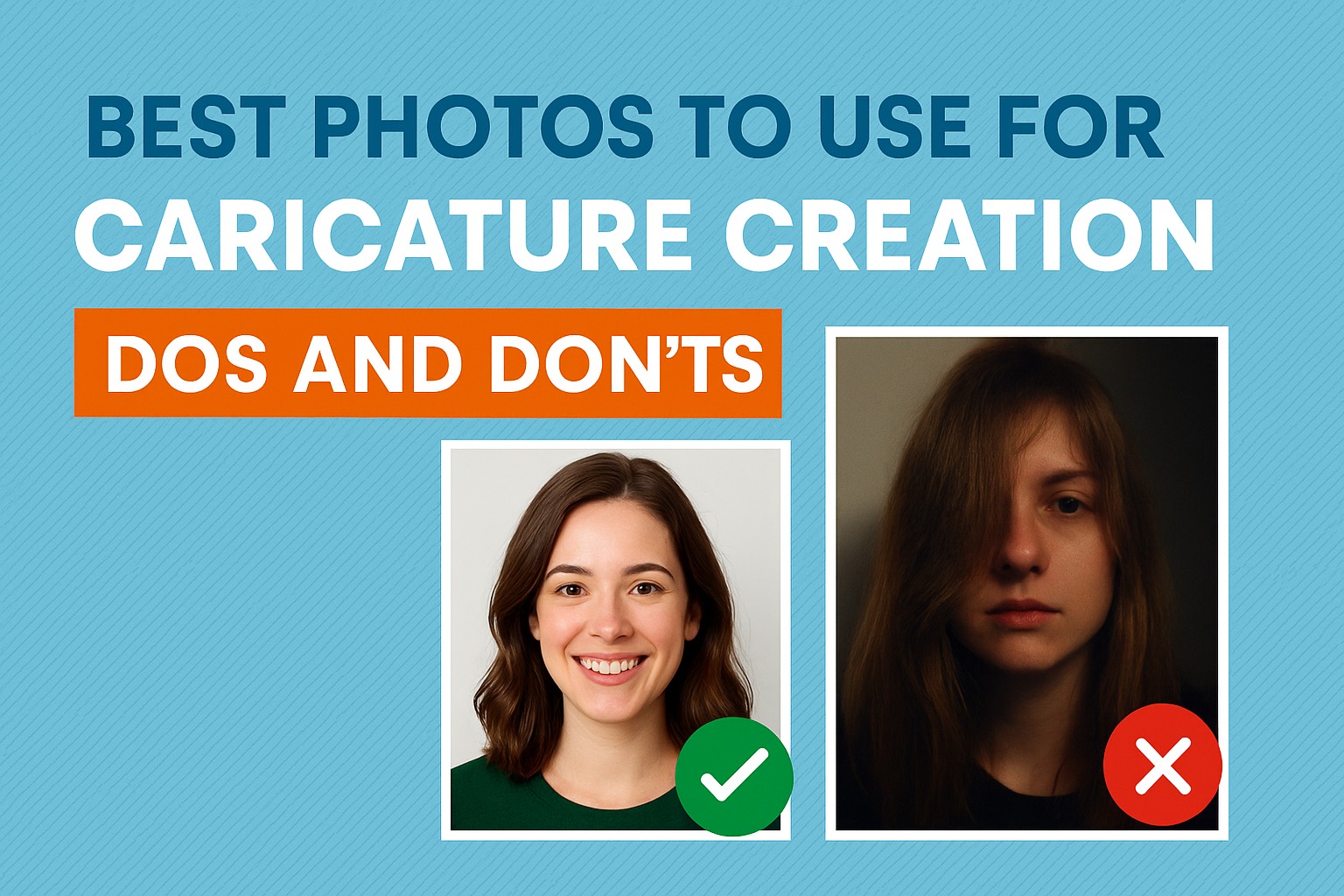Best Photos to Use for Caricature Creation (Dos and Don’ts)
By CaricatureMaker.net • October 19, 2025

Caricatures are all about personality. Whether it is a fun digital caricature gift or a professional illustration for a profile, the result depends heavily on one crucial thing, the photo you upload. Even the best artist or AI caricature generator cannot produce great results from a poor-quality or unclear image.
In this detailed guide, we explain exactly what kind of photos work best for caricature creation, common mistakes people make, and tips to help you choose the perfect shot every time.
Why the Right Photo Matters
Caricature art works by exaggerating and emphasizing distinct facial features such as the eyes, smile, nose, or hairstyle. For that to happen accurately, the artist or AI model needs a clear, well-lit, and front-facing photo.
If your photo is blurry, dark, or taken from an odd angle, the caricature might look distorted or lose the resemblance that makes it special.
The Dos: What Makes a Perfect Caricature Photo
Here are the essential things you should do when selecting a photo for caricature creation.
1. Use a High-Resolution Photo
A high-quality photo helps capture details like expressions, wrinkles, and textures that define your personality. Low-quality photos often result in vague, unrealistic caricatures.
Tip: Use photos at least 1000px by 1000px or larger. Avoid screenshots or compressed images from messaging apps.
2. Face the Camera Directly
Caricature artists and AI rely on symmetry and proportion. A front-facing photo helps capture both sides of your face evenly.
Tip: Look straight into the camera with your entire face visible. Avoid tilting your head too much.
Good Example: A centered selfie where both eyes, nose, and mouth are clearly visible.
3. Ensure Good Lighting
Lighting makes or breaks caricature accuracy. Harsh shadows or dim environments hide important features.
Tip: Use natural daylight whenever possible. Face toward a window or bright light source to avoid shadows.
Avoid overhead lighting that creates dark areas under your eyes or chin.
4. Show Your Full Face
Many people upload cropped or half-face selfies. This makes it impossible to create a balanced caricature.
Tip: Your entire face, ears, neck, and hairline should be visible. Hair and accessories often define personality, so do not leave them out.
5. Smile Naturally
A genuine smile adds character and liveliness to your caricature. Forced or exaggerated expressions can look awkward.
Tip: Smile comfortably and avoid exaggerated expressions unless that is the look you want.
6. Keep the Background Simple
Busy backgrounds can confuse the artist or AI and affect facial recognition.
Tip: Choose a plain or uncluttered background such as a light-colored wall.
7. Use Recent Photos
A caricature should represent your current look including hairstyle, beard, or glasses. Outdated photos may not reflect who you are today.
Tip: Use a photo taken within the last six months.
8. Include Accessories or Props (Optional)
If you want your caricature to show personality, include items such as sunglasses, hats, or uniforms.
Tip: Mention in your request if you want these items exaggerated or stylized.
The Don’ts: Common Photo Mistakes to Avoid
1. Do Not Use Blurry or Pixelated Photos
Blurry or low-resolution pictures make it impossible to capture fine details like expressions and contours.
Avoid zoomed-in screenshots, social media thumbnails, or photos taken with poor lighting.
2. Do Not Use Group Photos
In group pictures, faces are often small or partially hidden. This makes it difficult to isolate and enhance one person’s features.
Instead, take or upload a solo portrait rather than cropping your face from a group photo.
3. Do Not Use Side Profiles (Unless Requested)
Side profiles can work for stylized caricatures but not ideal for general caricature creation unless the artist specifically requests it.
Avoid photos taken from extreme angles and use straight-on or slightly turned photos instead.
4. Do Not Use Filters or Beauty Effects
Filters change skin tone, facial proportions, and natural features. These edits confuse the algorithm or artist.
Avoid photos with Snapchat, Instagram, or beautification filters and use raw, unfiltered images.
5. Do Not Cover Your Face
Sunglasses, masks, hands, or hair covering the face hide important details. Avoid partial obstructions and ensure your entire face is visible.
6. Do Not Take Pictures in Harsh Shadows
Uneven lighting distorts facial features, making exaggeration harder to balance.
Avoid standing under direct sunlight, dimly lit rooms, or using flash photography.
7. Do Not Upload Outdated Photos
A photo from years ago will not match your current look. Use a recent, natural-looking image that represents your current style.
Bonus Tips for the Perfect Caricature Photo
- Take multiple shots and choose the clearest one.
- Relax your expression; candid smiles work best.
- Use portrait mode for sharper results.
- Clean the camera lens before taking photos.
- Zoom in on your face to check if features are clear before uploading.
Quick Checklist Before Uploading
- Bright and natural lighting
- Face visible and centered
- No filters or obstructions
- High resolution
- Simple background
- Natural smile
Final Thoughts
A great caricature starts with a great photo. Think of it as giving the artist or AI the best possible canvas to work with. Whether you are creating a fun gift, a profile picture, or a keepsake, following these dos and don’ts ensures your caricature truly captures you in the most delightful and exaggerated way possible.